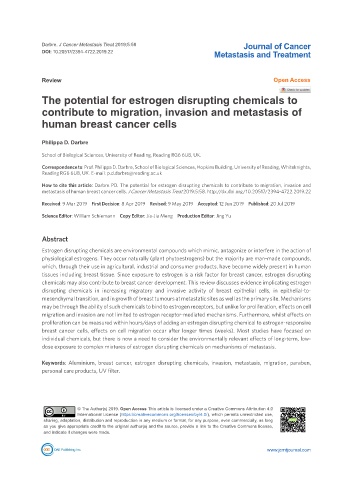Page 388 - Read Online
P. 388
Darbre. J Cancer Metastasis Treat 2019;5:58 Journal of Cancer
DOI: 10.20517/2394-4722.2019.22 Metastasis and Treatment
Review Open Access
The potential for estrogen disrupting chemicals to
contribute to migration, invasion and metastasis of
human breast cancer cells
Philippa D. Darbre
School of Biological Sciences, University of Reading, Reading RG6 6UB, UK.
Correspondence to: Prof. Philippa D. Darbre, School of Biological Sciences, Hopkins Building, University of Reading, Whiteknights,
Reading RG6 6UB, UK. E-mail: p.d.darbre@reading.ac.uk
How to cite this article: Darbre PD. The potential for estrogen disrupting chemicals to contribute to migration, invasion and
metastasis of human breast cancer cells. J Cancer Metastasis Treat 2019;5:58. http://dx.doi.org/10.20517/2394-4722.2019.22
Received: 9 Mar 2019 First Decision: 8 Apr 2019 Revised: 9 May 2019 Accepted: 12 Jun 2019 Published: 20 Jul 2019
Science Editor: William Schiemann Copy Editor: Jia-Jia Meng Production Editor: Jing Yu
Abstract
Estrogen disrupting chemicals are environmental compounds which mimic, antagonize or interfere in the action of
physiological estrogens. They occur naturally (plant phytoestrogens) but the majority are man-made compounds,
which, through their use in agricultural, industrial and consumer products, have become widely present in human
tissues including breast tissue. Since exposure to estrogen is a risk factor for breast cancer, estrogen disrupting
chemicals may also contribute to breast cancer development. This review discusses evidence implicating estrogen
disrupting chemicals in increasing migratory and invasive activity of breast epithelial cells, in epithelial-to-
mesenchymal transition, and in growth of breast tumours at metastatic sites as well as the primary site. Mechanisms
may be through the ability of such chemicals to bind to estrogen receptors, but unlike for proliferation, effects on cell
migration and invasion are not limited to estrogen receptor-mediated mechanisms. Furthermore, whilst effects on
proliferation can be measured within hours/days of adding an estrogen disrupting chemical to estrogen-responsive
breast cancer cells, effects on cell migration occur after longer times (weeks). Most studies have focused on
individual chemicals, but there is now a need to consider the environmentally relevant effects of long-term, low-
dose exposure to complex mixtures of estrogen disrupting chemicals on mechanisms of metastasis.
Keywords: Aluminium, breast cancer, estrogen disrupting chemicals, invasion, metastasis, migration, paraben,
personal care products, UV filter.
© The Author(s) 2019. Open Access This article is licensed under a Creative Commons Attribution 4.0
International License (https://creativecommons.org/licenses/by/4.0/), which permits unrestricted use,
sharing, adaptation, distribution and reproduction in any medium or format, for any purpose, even commercially, as long
as you give appropriate credit to the original author(s) and the source, provide a link to the Creative Commons license,
and indicate if changes were made.
www.jcmtjournal.com

